Tides
- The periodic short term rise and fall in the sea level is known as Tide. It is produced due to the gravitational interaction of earth, sun, and moon.
- It is caused by the combined effects of :
- The gravitational force exerted on Earth by the Sun
- The gravitational force exerted on Earth by the Moon
- Rotation of the Earth
- Tides occur due to a balance between all these forces.
- Energy of tides is much more than the rogue waves or storm breakers.
- Rogue waves are very high and limited in area; Tides are relatively low waves but stretch across the entire ocean.
- When the highest part, or crest, of the wave, reaches a particular location, high tide occurs; low tide corresponds to the lowest part of the wave, or its trough. The difference in height between the high tide and the low tide is called the tidal range.
- The highest tide in the World occurs in the Bay of Funday (Canada).
- The highest tide in India is recorded at Okha, Gujarat.
- The greatest tidal range in the world is found at the upper end of the Bay of Fundy in eastern Canada.
- Oscillating currents produced by tides are known as tidal streams. The moment that the tidal current ceases is called slack water or slack tide. The tide then reverses direction and is said to be turning. Slack water usually occurs near high water and low water.
- Tides are commonly semi-diurnal (two high waters and two low waters each day), or diurnal (one tidal cycle per day). The two high waters on a given day are typically not the same height (the daily inequality); these are the higher high water and the lower high water in tide tables. Similarly, the two low waters each day are the higher low water and the lower low water. The daily inequality is not consistent and is generally small when the Moon is over the equator.
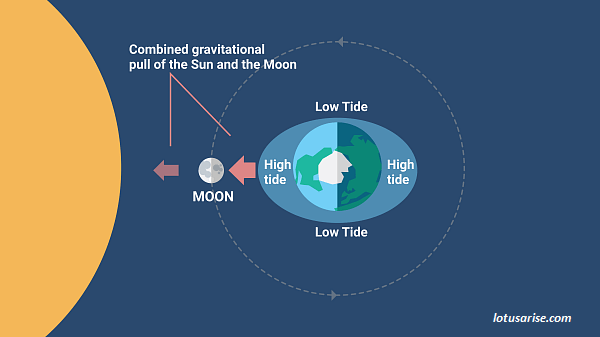
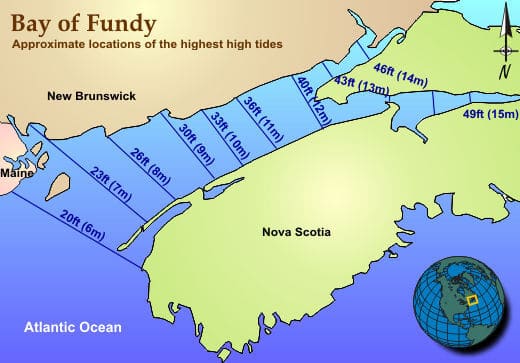
Tide changes proceed via the following stages:
- Sea level rises over several hours, covering the intertidal zone; flood tide.
- The water rises to its highest level, reaching high tide.
- Sea level falls over several hours, revealing the intertidal zone; ebb tide.
- The water stops falling, reaching low tide.
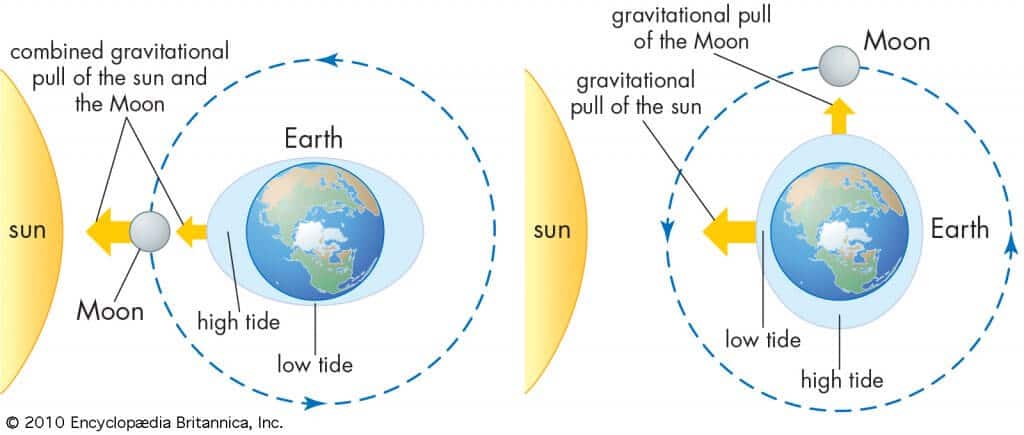
Types of Tides
Tides vary in their frequency, direction and movement from place to place and also from time to time.
Tides may be grouped into various types based on their frequency of occurrence in one day or 24 hours or based on their height.
Tides based on Frequency
- Semi-diurnal tide
- Diurnal tide
- Mixed tide
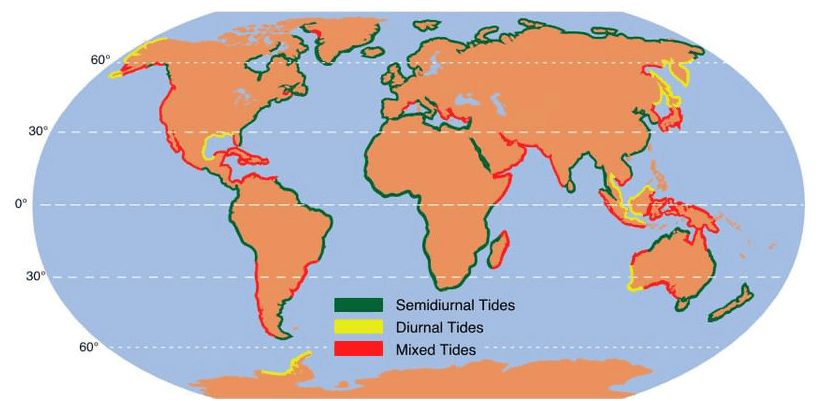
Semi-diurnal tide
- The most common tidal pattern, featuring two high tides and two low tides each day (Actually it varies between 3 tides to 4 tides –– 3 tides in rare cases but 4 is normal). The successive high or low tides are approximate of the same height.
Although tides occur twice a day, their interval is not exactly 12 hours. Instead, they occur at regular intervals of 12 hours and 25 minutes.
- This is because the moon revolves around the earth from west to east, and each day it moves a bit to the east if observed from the same place on earth at the same time on two consecutive days.
- This time lag explains the tide interval of 12 hours and- 25 minutes, as tides occur twice a day.
- A place in England—Southampton—experiences tides 6-8 times a day (2 high tides from North Sea + 2 high tides from English Channel + 2 neap tides from the North Sea + 2 neap tides from the English Channel). This happens because the North Sea and the English Channel push the water at different intervals.
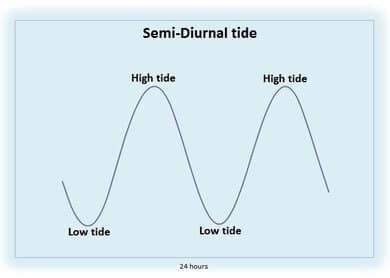
Diurnal tide
- There is only one high tide and one low tide during each day. The successive high and low tides are approximately of the same height.
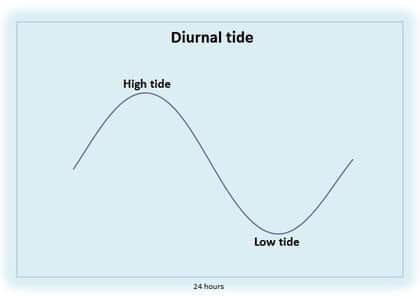
Mixed tide
- Tides having variations in height are known as mixed tides. These tides generally occur along the west coast of North America and on many islands of the Pacific Ocean.
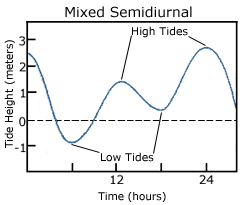
Tides based on the Sun, Moon and the Earth Positions
The height of rising water (high tide) varies appreciably depending upon the position of the sun and moon with respect to the earth. Spring tides and neap tides come under this category.

Spring tides
- The position of both the sun and the moon in relation to the earth has a direct bearing on tide height.
- When the sun, the moon, and the earth are in a straight line(a configuration known as a syzygy), the height of the tide will be higher.
- These are called spring tides and they occur twice a month, one on the full moon period and another during the new moon period.
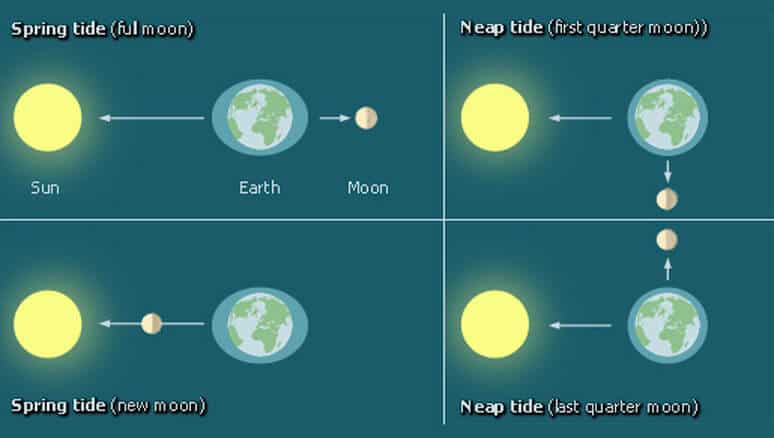
Neap tides
- When the Moon is at first quarter or third quarter, the Sun and Moon are separated by 90° when viewed from the Earth, and the solar tidal force partially cancels the Moon’s.
- The Moon’s attraction, though more than twice as strong as the sun’s, is diminished by the counteracting force of the sun’s gravitational pull.
- At these points in the lunar cycle, the tide’s range is at its minimum; this is called the neap tide, or neaps.
- Neap is an Anglo-Saxon word meaning “without the power”, as in forđganges nip (forthgoing without-the-power).
- Normally, there is a seven-day interval between the spring tides and neap tides.
- Like spring tides, these tides also occur twice a month.
The magnitude of tides based on Perigee and apogee of moon
- Once in a month, when the moon’s orbit is closest to the earth (perigee), unusually high and low tides occur. During this time the tidal range is greater than normal.
- Two weeks later, when the moon is farthest from earth (apogee), the moon’s gravitational force is limited and the tidal ranges are less than their average heights.
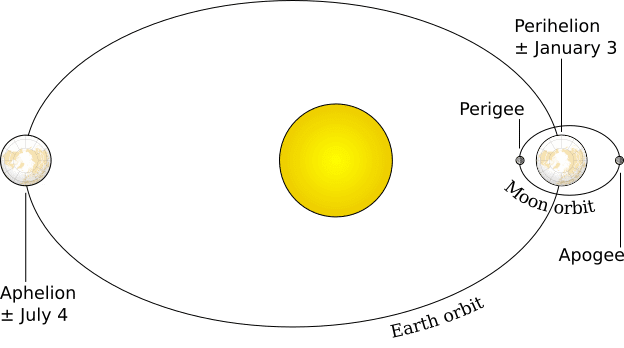
Magnitude of tides based on Perigee and Apogee of earth
- When the earth is closest to the sun (perihelion), around 3rd January each year, tidal ranges are also much greater, with unusually high and unusually low tides.
- When the earth is farthest from the sun (aphelion), around 4th July each year, tidal ranges are much less than average.
Apogee is the point, in an orbit about the earth, that is furthest from the earth..
Aphelion is the point in the elliptical orbit of a planet, comet, etc, where it is farthest from the sun.
Importance of Tides
Since tides are caused by the earth-moon-sun positions which are known accurately, the tides can be predicted well in advance. This helps the navigators and fishermen plan their activities.
Navigation
- Tidal heights are very important, especially harbours near rivers and within estuaries having shallow ‘bars’ [Marine Landforms] at the entrance, which prevent ships and boats from entering into the harbour.
- High tides help in navigation. They raise the water level close to the shores. This helps the ships to arrive at the harbour more easily.
- Tides generally help in making some of the rivers navigable for ocean-going vessels. London and Calcutta [Tidal Ports] have become important ports owing to the tidal nature of the mouths of the Thames and Hooghly respectively.
Fishing
- The high tides also help in fishing. Many more fish come closer to the shore during the high tide. This enables fishermen to get a plentiful catch.
Desilting
- Tides are also helpful in desilting the sediments and in removing polluted water from river estuaries.
Other
- Tides are used to generate electrical power (in Canada, France, Russia, and China).
- A 3 MW tidal power project was constructed at Durgaduani in Sunderbans of West Bengal.
Characteristics of Tides
- The tidal bulges on wide continental shelves have greater heights.
- In the open ocean, tidal currents are relatively weak.
- When tidal bulges hit the mid-oceanic islands they become low.
- The shape of bays and estuaries along a coastline can also magnify the intensity of tides.
- Funnel-shaped bays greatly change tidal magnitudes.
- Example: the Bay of Fundy –– Highest tidal range.
- The large continents on the planet, however, block the westward passage of the tidal bulges as the Earth rotates.
- Tidal patterns differ greatly from ocean to ocean and from location to location.
Tidal bore
- A tidal bore is a large wave or bore caused by the constriction of the spring tide as it enters a long, narrow, shallow inlet. These waves are resultant of the forces and turbulence in the whelps which causes a rumble roar.
- Tides also occur in gulfs. The gulfs with wide fronts and narrow rears experience higher tides.
- The in and out the movement of water into a gulf through channels called a tidal current.
- When a tide enters the narrow and shallow estuary of a river, the front of the tidal wave appears to be vertical owing to the piling up of water of the river against the tidal wave and the friction of the river bed.
- The steep-nosed tide crest looks like a vertical wall of water rushing upstream and is known as a tidal bore.
- The favorable conditions for tidal bore include the strength of the incoming tidal wave, the slim and depth of the channel, and the river flow.
- There are exceptions – the Amazon River is the largest river in the world. It empties into the Atlantic Ocean. The mouth of the Amazon is not narrow, but the river still has a strong tidal bore. A tidal bore develops here because the mouth of the river is shallow and dotted by many low-lying islands and sand bars.
- In India, tidal bores are common in the Hooghly river. The most powerful tidal bores occur in the Qiantang River in China.
- The name ‘bore’ is because of the sound the tidal current makes when it travels through narrow channels.
- Bores occur in relatively few locations worldwide, usually in areas with a large tidal range, typically more than 6 meters (20 ft) between high and low water.
- A tidal bore takes place during the flood tide and never during the ebb tide (Tidal bores almost never occur during neap tides. Neap tides happen during quarter moons when tides are weakest).
Impact of Tidal Bore
- Tides are stable and can be predicted. Tidal bores are less predictable and hence can be dangerous.
- The tidal bores adversely affect the shipping and navigation in the estuarine zone.
- Tidal bores of considerable magnitude can capsize boats and ships of considerable size.
- Strong tidal bores disrupt fishing zones in estuaries and gulfs.
- Tidal bores have an adverse impact on the ecology of the river mouth. The tidal-bore affected estuaries are the rich feeding zones and breeding grounds of several forms of wildlife.
- Animals slammed by the leading edge of a tidal wave can be buried in the silty water. For this reason, carnivores and scavengers are common sights behind tidal bores.
Reference: oceanservice.noaa.gov

Thanks
very nice
great notes thanks for the efforts
Thank you so much sir.. beautiful and brief explanation with animated pictures..
Kya ye notes enough hai
Prelims and gs1 ke liye
Yes, of course